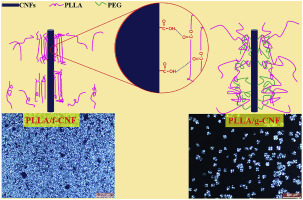Polymer Degradation and Stability ( IF 6.3 ) Pub Date : 2019-10-25 , DOI: 10.1016/j.polymdegradstab.2019.109014 Xin-zheng Jin , Xu Yu , Cheng Yang , Xiao-dong Qi , Yan-zhou Lei , Yong Wang

|
Interfacial interaction exhibits great role in determining the microstructure evolution and performance of the polymer composites. In most cases, it is expected to enhance the degree of the interfacial interaction as much as possible. In this work, carbon nanofibers (CNFs) were modified through two different methods, i.e. carboxyl functionalization in compounded H2SO4/HNO3 (3:1, vol/vol) to obtain the f-CNFs and then further reaction with poly (ethylene glycol) (PEG) to obtain the PEG-grafted CNFs (g-CNFs). The results showed that the grafting ratio of functional groups on f-CNFs was about 13.09 wt%, while after being grafted by PEG, the grafting ratio was further enhanced up to 50.95 wt%. Largely enhanced dispersion stability in aqueous was achieved for f-CNFs and g-CNFs. Surface modification also improved the dispersion states of CNFs in the poly (l-lactic acid) (PLLA) composites, and stronger interfacial adhesion was achieved in the PLLA/f-CNF and PLLA/g-CNF composites. Studying on crystallization behaviors of the composites showed that raw CNFs (r-CNFs) and f-CNFs exhibited good nucleation effects on PLLA crystallization with nucleation activation energies of −12.49 and −11.81 kJ/mol, respectively, while the nucleation effect of the g-CNFs was very weak and the nucleation activation energy was −5.45 kJ/mol. However, compared with the PLLA/f-CNF composite, the PLLA/g-CNF composite exhibited largely enhanced growth rate of spherulites during the isothermal crystallization process. Researches about the hydrolytic degradation behaviors of the PLLA composites showed that incorporating f-CNFs accelerated the hydrolytic degradation while it was greatly suppressed by g-CNFs. For example, the PLLA/g–CNF–2 sample showed much lower hydrolytic degradation rate (0.0134%/h) compared with the PLLA/r–CNF–2 (0.0521%/h) and PLLA/f–CNF–2 (0.086%/h) samples. This work confirms that appropriate interfacial interaction is more favorable for the realization of the nucleation effect of CNFs and the acceleration of the hydrolytic degradation of the PLLA matrix, while strong interfacial interaction achieved through grafting polymer chains not only suppresses the nucleation effect but also enhances the hydrolytic degradation resistance of the PLLA matrix.
中文翻译:

具有不同表面改性的碳纳米纤维诱导的聚(l-丙交酯)的结晶和水解降解行为
界面相互作用在决定聚合物复合材料的微观结构演变和性能方面发挥着重要作用。在大多数情况下,期望尽可能提高界面相互作用的程度。在这项工作中,碳纳米纤维(CNFs)通过两种不同的方法进行了改性,即在复合H 2 SO 4 / HNO 3中进行羧基官能化(3∶1,体积/体积)获得f-CNF,然后与聚(乙二醇)(PEG)进一步反应以获得PEG接枝的CNF(g-CNF)。结果表明,f-CNFs上的官能团接枝率为13.09 wt%,而PEG接枝后,接枝率进一步提高到50.95 wt%。对于f-CNF和g-CNF,在水中的分散稳定性大大提高。表面改性还改善CNF的分散状态在聚(升-乳酸)(PLLA)复合材料,并在PLLA / f-CNF和PLLA / g-CNF复合材料中实现了更强的界面粘合力。复合材料的结晶行为研究表明,原始CNF(r-CNFs)和f-CNFs对PLLA结晶具有良好的成核作用,成核活化能分别为-12.49和-11.81 kJ / mol,而g的成核作用-CNF非常弱,成核活化能为-5.45 kJ / mol。然而,与PLLA / f-CNF复合材料相比,PLLA / g-CNF复合材料在等温结晶过程中显示出大大提高的球晶生长速率。关于PLLA复合材料的水解降解行为的研究表明,掺入f-CNFs可以加速水解降解,而被g-CNFs大大抑制。例如,与PLLA / r-CNF-2(0.0521%/ h)和PLLA / f-CNF-2(0.086%/ h)相比,PLLA / g-CNF-2样品的水解降解率(0.0134%/ h)低得多)样品。这项工作证实了适当的界面相互作用更有利于实现CNF的成核作用和促进PLLA基质的水解降解,而通过接枝聚合物链实现的强界面相互作用不仅抑制了成核作用,而且还增强了PLLA基质的抗水解降解性。











































 京公网安备 11010802027423号
京公网安备 11010802027423号